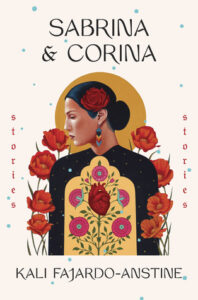By: Saije Rusimovici, Staff Writer

Sabrina & Corina: Stories by Kali Fajardo-Anstine
This contemporary collection of stories is rated just over four stars on Goodreads, though in my opinion, it deserves five. Fajardo-Anstine crafts “a narrative of unrelenting feminine power” that places emphasis on womanhood and female connection as a way to overcome oppression, poverty and systemic injustice. Each story follows a different cast of Latina characters of Indigenous ancestry as they navigate “the universal experiences of abandonment, heritage, and an eternal sense of home.” Though their stories are different, each character embodies the relentless force of feminine power in the face of abuse, relationships, and the gentrification of Denver, Colorado, where several of the stories take place.
Sabrina and Corina exposes the lasting implications of what Fajardo-Anstine refers to as neocolonialism, “a set of economic, cultural, and social principles that emerges from colonialism.” In “Tomi,” a woman who has just been released from prison returns to her childhood neighbourhood, and the gentrification reminds her of tornados “demolishing one block while casually leaving another intact.” The author highlights gentrification as a form of neocolonial violence “which continues to displace the lives and erase the experiences, cultures, and communities of contemporary Indigenous and Latinx neighbourhoods — in favour of creating profits for both corporations and local governments.”
Each of Fajardo-Anstine’s unique stories are moving and thought-provoking. She reaches the reader with simple, conversational language. With every story, it seems as though she is unravelling intimate, personal secrets, which keep the reader engaged and critical of the colonial societies we continue to inhabit today.
This Is Paradise: Stories by Kristiana Kahakauwila
Hawaiʻi is often thought of as a luxury vacation spot — a place to enjoy beautiful beaches and warm weather. Often, the existence and needs of the island’s Indigenous people are overlooked. The stories in this book offer “an unforgettable portrait of life as it’s truly being lived” in modern-day Hawaiʻi. In a collection of six short stories, Kahakauwila explores the tensions between Native Hawaiians and tourists, expressed through slice-of-life stories. There are many misconceptions about Native Hawaiians, and the author carefully and purposefully unravels them, drawing the reader in by taking them on a journey across the islands of Maui, Oahu, Kauaʻi and the Big Island.
Despite transporting readers to Hawaiʻi, the stories challenge the common perceptions of Hawaiʻi as a traveler’s “paradise” by recognizing the positionality of Native Hawaiian people on the island. Tourists often fail to recognize issues Native Hawaiian women face in particular, including laborious underpaid housekeeping work and unaffordable housing. This book “makes the point that lives in ‘paradise’ are just as complicated as anywhere else.”
Hearts Unbroken by Cynthia Leitich Smith
Hearts Unbroken is a young adult romance crafted by New York Times bestselling author, Cynthia Leitich Smith, a member of the Muscogee Creek Nation. The novel exposes the isolating experience of being an Indigenous high school student in a predominately white, middle-class town in Kansas. Louise Wolfe is a senior who enjoys spending most of her time working for the school newspaper. When the school’s musical director takes an inclusive approach to casting The Wizard of Oz, the townspeople’s prejudice is exposed through hostile commentary and behaviour, and anonymous threats. While grappling with the tensions growing between students, parents, and teachers, Louise begins to develop feelings for Joey Kairouz, a photojournalist for the paper, and finds that navigating dating as an Indigenous person is complicated.
I picked this book because it’s comprehensive and approachable for readers, while tackling important issues like systemic racism, microaggressions, and discrimination — all factors which greatly impact Indigenous adolescents. When the townspeople expose their prejudice from something as trivial as a school play, the reader questions how perceptions of minority groups influence internalized responses to casting choices made in popular media. It brings us to reflect on our positionality as settlers and how we can be more conscious of colonialism’s influence on our perceptions of Indigenous peoples.